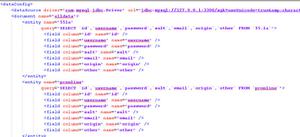varcharint查询到底什么情况下走索引?

一个字符类型的、一个int类型的,查询的时候到底会不会走索引,其实很多工作了几年的开发人员有时也会晕,下面就用具体事例来测试一下。
1. 准备工作
先准备2张表,以备后续测试使用。
表1:创建表test1,总共3列,其中id 是主键(int),c_no 为int型,且有索引,c_2为普通字段
/*创建表test1 */createtable test1(id intprimarykey,c_no int ,c_2 varchar(1),key c_no(c_no));
/* 插入一些测试数据 */
insertinto test1 values(1,1,"0"),(2,2,"1"),(3,4,"1"),(4,6,"0"),(5,7,""1),(6,11,"2"),(7,5,"3"),(8,100,"0"),(9,30,"1"),(10,50,"0");
表2: 创建表test1,总共3列,其中id 是主键(int),c_no 为字符型,且有索引,c_2为普通字段
/* 创建test2 */createtable test2(id intprimarykey auto_increment,c_no varchar(11) ,c2 varchar(2),key c_no(c_no));
/* 插入一些测试数据 */
insertinto test2 values(1,"5","1"),(4,"100","0"),(3,"30","1"),(10,"500","0"),(11,"20","0"),(12,"20a","0"),(15,"020b","1");
两张表的差异是c_no的字段类型不同。
2. 等值查询测试
2.1 测试test1
test1.c_no字段为int类型,下面分别用整型和字符串进行比较,查看是否走索引。对应的执行计划如下:
mysql> explain select*from test1 where c_no="100";+----+-------------+-------+------------+------+---------------+------+---------+-------+------+----------+-------+| id | select_type |table| partitions | type | possible_keys |key| key_len | ref | rows | filtered | Extra |
+----+-------------+-------+------------+------+---------------+------+---------+-------+------+----------+-------+
|1| SIMPLE | test1 |NULL| ref | c_no | c_no |5| const |1|100.00|NULL|
+----+-------------+-------+------------+------+---------------+------+---------+-------+------+----------+-------+
1 row inset, 1 warning (0.00 sec)
mysql> explain select*from test1 where c_no=100;
+----+-------------+-------+------------+------+---------------+------+---------+-------+------+----------+-------+
| id | select_type |table| partitions | type | possible_keys |key| key_len | ref | rows | filtered | Extra |
+----+-------------+-------+------------+------+---------------+------+---------+-------+------+----------+-------+
|1| SIMPLE | test1 |NULL| ref | c_no | c_no |5| const |1|100.00|NULL|
+----+-------------+-------+------------+------+---------------+------+---------+-------+------+----------+-------+
1 row inset, 1 warning (0.00 sec)
可见,两种方式均走索引了,且走的是c_no的索引,类型为ref为const(常量的等值查询),扫行数为1
也就是说当表中的字段类型为整型时,无论查询用字符串类型的数字还是int类型的数字均能走索引。其中用int类型的值查询能走索引可以容易理解,那么,字符型的为什么能走? 其实这里的字符类型做了隐式转化,上例中就相当于
mysql> explain select*from test1 where c_no=CAST("100" as UNSIGNED);+----+-------------+-------+------------+------+---------------+------+---------+-------+------+----------+-------+| id | select_type |table| partitions | type | possible_keys |key| key_len | ref | rows | filtered | Extra |
+----+-------------+-------+------------+------+---------------+------+---------+-------+------+----------+-------+
|1| SIMPLE | test1 |NULL| ref | c_no | c_no |5| const |1|100.00|NULL|
+----+-------------+-------+------------+------+---------------+------+---------+-------+------+----------+-------+
1 row inset, 1 warning (0.00 sec)
2.2 测试 test2 表
以同样的方式测试一下test2的查询情况
先测试正常情况下字符型与字符型比较,结果可想而知,可以走索引,如下:
mysql> explain select*from test2 where c_no="100";+----+-------------+-------+------------+------+---------------+------+---------+-------+------+----------+-------+| id | select_type |table| partitions | type | possible_keys |key| key_len | ref | rows | filtered | Extra |
+----+-------------+-------+------------+------+---------------+------+---------+-------+------+----------+-------+
|1| SIMPLE | test2 |NULL| ref | c_no | c_no |47| const |1|100.00|NULL|
+----+-------------+-------+------------+------+---------------+------+---------+-------+------+----------+-------+
1 row inset, 1 warning (0.00 sec)
而,如果是整型再查呢?结果如下(很遗憾,不能走索引了)
mysql> explain select*from test2 where c_no=100;+----+-------------+-------+------------+------+---------------+------+---------+------+------+----------+-------------+| id | select_type |table| partitions | type | possible_keys |key| key_len | ref | rows | filtered | Extra |
+----+-------------+-------+------------+------+---------------+------+---------+------+------+----------+-------------+
|1| SIMPLE | test2 |NULL|ALL| c_no |NULL|NULL|NULL|7|14.29| Using where|
+----+-------------+-------+------------+------+---------------+------+---------+------+------+----------+-------------+
1 row inset, 3 warnings (0.00 sec)
也就是说,表中字段为字符类型的时候,查询的值为整型时,无法走索引了。
那这句相当于如下情况:
mysql> explain select*from test2 wherecast(c_no as unsigned)=100;+----+-------------+-------+------------+------+---------------+------+---------+------+------+----------+-------------+| id | select_type |table| partitions | type | possible_keys |key| key_len | ref | rows | filtered | Extra |
+----+-------------+-------+------------+------+---------------+------+---------+------+------+----------+-------------+
|1| SIMPLE | test2 |NULL|ALL|NULL|NULL|NULL|NULL|7|100.00| Using where|
+----+-------------+-------+------------+------+---------------+------+---------+------+------+----------+-------------+
1 row inset, 1 warning (0.00 sec)
也就是c_no做了隐式转化。因为如果是100做了影视转化,那么结果应该是可以走索引,例如:
mysql> explain select*from test2 where c_no=cast(100aschar);+----+-------------+-------+------------+------+---------------+------+---------+-------+------+----------+-------+| id | select_type |table| partitions | type | possible_keys |key| key_len | ref | rows | filtered | Extra |
+----+-------------+-------+------------+------+---------------+------+---------+-------+------+----------+-------+
|1| SIMPLE | test2 |NULL| ref | c_no | c_no |47| const |1|100.00|NULL|
+----+-------------+-------+------------+------+---------------+------+---------+-------+------+----------+-------+
1 row inset, 1 warning (0.00 sec)
由此,我们也应证了如果字段做了函数计算后,该列上即使有索引也无法使用(MySQL8.0之前的版本)。
2.3 进一步测试
其实针对test2表 还可以测试一点,进一步证明是c_no字段做了隐式转化,例如:
mysql>select*from test2 where c_no=20;+----+------+------+| id | c_no | c2 |
+----+------+------+
|11|20|0|
|12| 20a |0|
|15| 020b |1|
+----+------+------+
3 rows inset, 2 warnings (0.00 sec)
另外,看到了2个警告,内容如下:
mysql> show warnings;+---------+------+------------------------------------------+|Level| Code | Message |
+---------+------+------------------------------------------+
| Warning |1292| Truncated incorrect DOUBLE value: "20a"|
| Warning |1292| Truncated incorrect DOUBLE value: "020b"|
+---------+------+------------------------------------------+
2 rows inset (0.00 sec)
更加证明了转化为数字型(预转为double)
3. 小结
通过上面的简单测试,即可发现如下结论:
- 当表中的字段类型为整型时,无论查询用字符串类型的数字还是int类型的数字均能走索引;
- 表中字段为字符类型的时候,查询的值为整型时,无法走索引;
- 如果字段做了函数计算后,该列上即使有索引也无法使用(MySQL8.0之前的版本)
因此开发同学在写SQL的时候要注意SQL的写法,缺少一个单引号可能导致很大的性能差异。
以上是 varcharint查询到底什么情况下走索引? 的全部内容, 来源链接: utcz.com/z/532962.html








